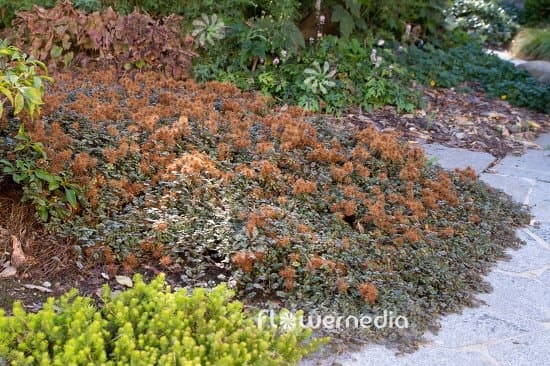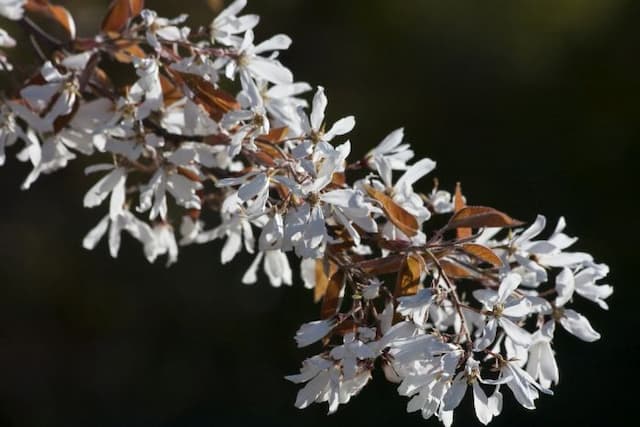Great Burnet Sanguisorba 'Blackthorn'

ABOUT
Sanguisorba 'Blackthorn', is a perennial garden plant known for its unique and attractive blooms. The flowers of 'Blackthorn' are its most striking feature, rising above the foliage on stiff, upright stems. The blooms are bottlebrush-like in appearance, consisting of dense clusters of small, dark maroon to almost black blossoms that create a dramatic visual effect. These flowers can add a touch of elegance and intrigue to the garden when they appear in the summer and early fall. The foliage of the plant is also quite distinctive. The leaves are typically pinnate or divided into leaflets, with each leaf featuring a series of oval to rounded leaflets with toothed edges. The overall look of the foliage is full and somewhat fern-like, creating a lush green backdrop for the dramatic flowers. The color of the leaves is usually a deep green which contrasts nicely against the dark tones of the blossoms. Overall, Sanguisorba 'Blackthorn' has a mounding form with a tidy and compact growth habit that makes it well-suited for use in borders or as a specimen plant in a garden setting. Its unique flower spikes and lush foliage provide visual interest and texture, while also attracting pollinators like bees and butterflies.
About this plant
 Names
NamesFamily
Rosaceae
Synonyms
Blackthorn Pimpernel, Blackthorn Burnet
Common names
Sanguisorba 'Blackthorn'.
 Toxicity
ToxicityTo humans
Sanguisorba 'Blackthorn', commonly known as Great Burnet, is not typically considered toxic to humans. There is limited information on its toxicity, but it is not commonly reported to cause poisoning when touched or ingested. However, as with many plants, individual allergies or sensitivities could potentially occur. Consuming any plant not specifically identified as edible is generally discouraged due to the potential for adverse reactions. If someone has ingested Sanguisorba 'Blackthorn' and is feeling ill, it’s important to consult a healthcare provider.
To pets
Sanguisorba 'Blackthorn', commonly referred to as Great Burnet, is not widely known to be toxic to pets. There is no substantive evidence to suggest that this plant poses a significant risk of poisoning to animals if ingested. However, as with any non-food plant, it is possible for pets to experience mild gastrointestinal upset if they consume this plant in large quantities. Owners should always monitor their pets and prevent them from eating ornamental plants, and if any signs of illness occur after ingestion, they should contact a veterinarian.
 Characteristics
CharacteristicsLife cycle
Perennials
Foliage type
Deciduous
Color of leaves
Green
Flower color
Red
Height
3-4 feet (0.91-1.22 meters)
Spread
1-2 feet (0.30-0.61 meters)
Plant type
Herb
Hardiness zones
4-9
Native area
Temperate Northern Hemisphere
Benefits
 General Benefits
General Benefits- Ornamental Value: Sanguisorba 'Blackthorn' has striking dark-purple to almost black flowers that add a unique aesthetic to gardens and landscapes.
- Attracts Wildlife: The flowers are attractive to pollinators such as bees and butterflies, which are beneficial for the garden ecosystem.
- Low Maintenance: It is a hardy perennial that requires minimal upkeep once established, making it ideal for gardeners seeking low-maintenance plants.
- Drought Tolerance: Once established, Sanguisorba 'Blackthorn' can tolerate periods of drought, making it suitable for xeriscaping or gardens with limited water access.
- Long Blooming Period: The plant has a long flowering season, often from midsummer into fall, providing extended interest in the garden.
- Deer Resistance: The plant is generally resistant to deer, which makes it a good choice for gardens in areas with high deer populations.
- Cold Tolerant: Sanguisorba 'Blackthorn' is tolerant of cold temperatures and can survive in cooler climates, which makes it versatile for various garden zones.
- Positive Effect on Ecosystem: It contributes to the biodiversity of the garden by providing habitat and food sources for various insects and birds.
- Versatile Usage: The plant can be used in a variety of garden designs, including borders, wildflower meadows, and naturalistic plantings.
- Cut Flower: Its unique flowers make it an excellent candidate for fresh or dried floral arrangements.
 Medical Properties
Medical Properties- Anti-inflammatory: Sanguisorba 'Blackthorn' may contain compounds that help reduce inflammation.
- Antibacterial: Some studies suggest it has potential antibacterial effects.
- Antioxidant: The plant may contain antioxidants that help protect cells from damage.
- Hemostatic: Traditionally, it has been used to stop bleeding.
- Gastrointestinal aid: It might be beneficial for treating gastrointestinal disorders.
 Air-purifying Qualities
Air-purifying QualitiesThis plant is not specifically known for air purifying qualities.
 Other Uses
Other Uses- Sanguisorba 'Blackthorn', commonly known as Burnet, can be used as a natural dye for fabrics, giving a range of colors from greens to browns depending on the mordant used.
- Burnet is sometimes incorporated in potpourri mixes because of its interesting seed head shape, adding texture and visual appeal to the mixture.
- The dried seed heads of Burnet can be used in floral arrangements to provide a striking contrast to other flowers and are valued for their long-lasting qualities.
- In garden landscapes, Burnet can sometimes be used as a companion plant to deter certain pests from more susceptible garden plants.
- Burnet, with its robust growth habit, can be planted as a ground cover to prevent soil erosion in areas where other plants might struggle to thrive.
- The root system of Burnet can be used in rain gardens or water purification projects as they help in filtering pollutants from runoff water.
- Burnet may be used in educational projects to help students learn about pollination as it attracts various bee species and other pollinators.
- In some regions, Burnet leaves are used as a food wrap, offering a sustainable way to package and preserve perishable goods naturally.
- Due to its unique leaf shape and texture, Burnet is also used in craft projects, such as leaf printing art or nature-inspired decorations.
- Burnet can be grown as a border plant to define garden spaces, pathways, or property lines due to its upright and clumping form.
Interesting Facts
 Feng Shui
Feng ShuiThe plant Blackthorn is not used in Feng Shui practice.
 Zodiac Sign Compitability
Zodiac Sign CompitabilityThe plant Blackthorn is not used in astrology practice.
 Plant Symbolism
Plant Symbolism- Healing: Sanguisorba officinalis is commonly known as Great Burnet, historically used for its medicinal properties, suggesting the symbolic meaning of healing and soothing ailments.
- Purity: The deep red, almost black color of Great Burnet's spherical flower heads can be seen to symbolize purity or cleansing of the blood, due to the plant’s traditional use in blood purification.
- Protection: In some cultures, Great Burnet was believed to offer protection against evil and harm, possibly due to its astringent qualities and association with blood.
- Harmony: The way Great Burnet's flowers form a tight-knit, harmonious sphere might symbolize unity and togetherness in social or community contexts.
- Perseverance: As a plant that can thrive in challenging environments, Great Burnet could represent the ability to endure and persist through difficulties.
 Water
WaterThe Great Burnet should be watered deeply once a week during periods of drought or when the top inch of soil feels dry. Ideally, it is best to provide the plant with about one gallon of water per week under normal weather conditions. In very hot weather, it may require an additional half gallon to maintain proper moisture levels, but be sure to avoid overwatering as the plant does not like soggy soil. Cut back on water in the fall as the plant prepares for dormancy.
 Light
LightGreat Burnet thrives in full sun to partial shade. It prefers a spot where it can receive at least six hours of direct sunlight daily. However, in very hot climates, protection from the intense afternoon sun with some dappled shade is beneficial to prevent stress on the plant.
 Temperature
TemperatureGreat Burnet is tolerant to a range of temperatures but grows best in conditions between 60 and 75 degrees Fahrenheit. It can survive minimum temperatures down to around 0 degrees Fahrenheit but may suffer if exposed to extremes beyond this range for prolonged periods. Ensuring good air circulation can help it withstand higher temperatures in the summer.
 Pruning
PruningTo maintain a tidy appearance and promote vigorous growth, prune the Great Burnet in late winter or early spring before new growth starts. Deadheading the spent flower stalks during the growing season can encourage more blooms. Cut back the entire plant to the ground after the first frost to prepare it for winter.
 Cleaning
CleaningAs needed
 Soil
SoilThe Great Burnet prefers moist, well-drained soil with a high organic matter content; loamy soils are ideal. Aim for a pH range of 6.0 to 7.0 for optimal growth.
 Repotting
RepottingGreat Burnet typically doesn't need frequent repotting. It's a hardy perennial, so repot or divide every 3-5 years to maintain vigor.
 Humidity & Misting
Humidity & MistingGreat Burnet is tolerant of a range of humidity levels but thrives best in average garden conditions without the need for added humidity.
 Suitable locations
Suitable locationsIndoor
Provide bright light, ensure good air circulation for Great Burnet.
Outdoor
Plant in full sun/part shade, keep soil consistently moist for Great Burnet.
Hardiness zone
4-9 USDA
 Life cycle
Life cycleSanguisorba 'Blackthorn', commonly known as Great Burnet, begins its life cycle as a seed, which requires a period of cold stratification to promote germination. Once conditions are favorable, usually in spring, the seed germinates, and seedlings emerge, developing into young plants with a basal rosette of pinnate leaves. As the plant matures, it develops a strong root system and sends up tall, upright stems in late spring to early summer. By midsummer, the Great Burnet produces distinctive dark maroon to purple bottlebrush-like flower spikes that are pollinated by insects. After pollination, seeds develop and are eventually dispersed near the parent plant or carried further by wind or wildlife. The plant goes dormant in winter, retreating to its rootstock before resuming growth in the next season.
 Propogation
PropogationPropogation time
Spring to summer
Sanguisorba 'Blackthorn', more commonly known as Great Burnet, is typically propagated by division, which is considered the most popular method for this perennial plant. The ideal time for division is in the spring or early fall when the plant is not in active growth. To propagate by division, carefully lift the plant from the ground and use a sharp spade or knife to divide the clump into smaller sections, ensuring that each new section has a portion of the root system and several shoots. The divisions can then be immediately replanted in a prepared garden bed or pot, spaced about 18 inches apart to allow for growth. After planting, water the new divisions thoroughly to help establish them. This method allows for the quick multiplication of plants while maintaining the traits of the parent plant.







![Tree amelanchier [Tradition]](/_next/image?url=https%3A%2F%2Fplants-admin.emdemapps.com%2Fimages%2Fplants%2F%2Fimages%2F604b56afa99a2.png&w=640&q=75)

